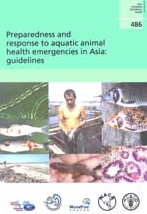Preparedness and response to aquatic animal health emergencies in Asia: guidelines

This document provides guidance to assist developing countries in improving national emergency preparedness in order to maximize the efficiency of response to serious outbreaks of aquatic animal diseases. It is a product of the Food and Agriculture Organization of the United Nations (FAO)/Network of Aquaculture Centres in Asia-Pacific (NACA)/WorldFish Center (WFC) Regional Workshop on Preparedness and Response to Aquatic Animal Health Emergencies, held in Jakarta, Indonesia from 21–23 September 2004. The workshop, which was hosted by the Government of Indonesia, Ministry of Marine Affairs and Fisheries (MMAF), was attended by 51 participants, including national policy-makers and scientists from the Asian Region, and international experts and resource persons from both the region and elsewhere.
The primary objective of biosecurity arrangements is to prevent the incursion of exotic pathogens and pests. Knowing, however, that the risk of such incursions can never be reduced to zero, such arrangements must also include plans to ensure a rapid, well organized and appropriate response to an emergency disease incident. Infectious disease emergencies may arise within a country through incursions of known exotic diseases (transboundary aquatic animal diseases, TAADs), by a sudden change in the behaviour or distribution of endemic diseases, or via the appearance of previously unrecognized diseases. Effective emergency preparedness through contingency planning, early detection and a rapid response is critical to the successful management of such disease outbreaks. A strong national approach to contingency planning is essential to ensure that the necessary operational capability is in place so that early detection and effective responses are achieved. Recovery from an emergency disease response must be followed by measures to ensure that freedom from the particular disease is again maintained.
Having the capability to deal with emergency diseases involves systematic planning, training, and simulation exercises (field trials or “dummy runs”), as well as having access to an appropriate level of resources, including trained personnel, essential equipment and the necessary financial and legal mechanisms. Although a comprehensive capability in many countries will take a long time to achieve, it is hoped that this manual will assist developing countries in laying foundations within the framework of whatever resources presently exist.